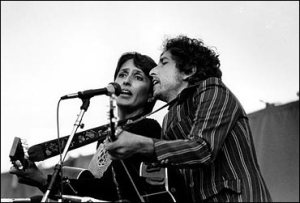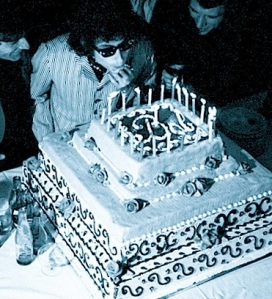
It’s only Wednesday of 1981, but I’m calling it on Shot of Love and moving on to some of the bootlegs. This was an album that I had had no exposure to before Sunday morning when I listened to it for the first time, and it is an album that I probably won’t be going back to much again. This album has two tremendous songs: “The Groom’s Still Waiting at the Altar” and “Every Grain of Sand”. Pretty much everything else I have some troubles with. The first time I listened to the album I thought that it might be a contender for “worst ever status”. It’s not that bad, but it’s certainly the worst of his three born-again albums.
In a 1983 interview with NME, Dylan will call “Shot of Love” “my most perfect song”. Wow. This is a hard concept for me to wrap my brain around, since I find it both musically and lyrically ordinary. There’s nothing really worth grasping here, and nothing very memorable in it at all.
“Heart of Mine” and “Groom” I have already written about, so I’ll pass those by here.
“Property of Jesus” and “Watered-Down Love” I think are pretty akin. My friend Rusty characterized Saved as “more finger-pointing music”. I’m not sure that was the case with that album, but it certainly is with both of these songs, both of which represent the worst kind of tendencies of certain forms of Christian faith. Where “I Believe in You” is actually a pretty beautiful song about someone who feels put upon for his faith, but maintains it anyway, “Property of Jesus” simply sounds like sulking:
Go ahead and talk about him because he makes you doubt
Because he has denied himself the things that you can’t live without
Laugh at him behind his back just like the others do
Remind him of what he used to be when he comes walkin’ through
He’s the property of Jesus
Resent him to the bone
You got something better
You’ve got a heart of stone
The song is “I know you’re laughing at me, but I’ll have the last laugh because you’re a jerk”. This is actually a somewhat common Dylan refrain, but here it is not clever, charming, nor convincing. This is pretty simple name-calling, and while that can work (see: “Idiot Wind”), it doesn’t here at all. Similarly, “Watered-Down Love” is so smug that it’s hard to listen to:
Love that’s pure hopes all things
Believes all things, won’t pull no strings
Won’t sneak up into your room, tall, dark and handsome
Capture your heart and hold it for ransom
You don’t want a love that’s pure
You wanna drown love
You want a watered-down love
Dylan’s aspersions on romantic love in favour of the love of God are, at least, somewhat on point, but the finger-pointing tone lacks generosity. He has moved on from the “I’m celebrating my love of God” phase to the “You people piss me off because you’re not joining me” phase. It’s not attractive.
“Lenny Bruce” is a song that Dylan told Dave Herman that he wrote “in five minutes” and it kind of sounds like it. A mystifying tribute to the comic who died fifteen years earlier, and whom Dylan once met and who he also supported on one of his obscenity charges, the song makes bizarre claims. This song has three strong contenders for worst ever Dylan lyrics. In order from worse to worst:
- Never did get any Golden Globe award
- They stamped him and they labeled him like they do with pants and shirts
- Never robbed any churches nor cut off any babies’ heads
If only everyone who refrained from beheading babies could have songs written about them. For some reason I have a strong recollection of this song from the late-1980s. I must have had it on a tape (possibly a bootleg). It doesn’t appear on any greatest hits collections and I didn’t own this album, but I know the song well. Once upon a time I think I probably liked it, but once upon a time I thought Bruce was a majorly important cultural figure – I even watched the Dustin Hoffman biopic. Today, not so much. Though I am glad to learn that he wasn’t a baby beheader.
“Dead Man, Dead Man” is a really passable song. Not a great one, but the chorus is good (especially live) and lyrically it’s pretty sophisticated. This one is worth keeping. “In the Summertime” throws me almost every time because the opening sounds so similar to “I Pity the Poor Immigrant”. It’s a nice song, but nothing memorable. Good harmonica playing. “Trouble” is a bit of a dud.
The culmination of the whole album is “Every Grain of Sand”, the last track on the second side. This is his best song since Blood on the Tracks, and maybe one of his top ten of all time. The entire Christian phase is worthwhile simply for this song. It is a brilliant composition that actually expresses his Christian beliefs in a manner that makes you want to share them. It contains doubt and reverence. Tim Riley notes that it sounds like it could be a hymn passed down through the ages, and he’s exactly right. The song feels larger than Dylan, as most of his best ones do. This is the total package: it’s even one of Dylan’s better singing performances. This is a truly lovely song.
Here it is, the highpoint of the entire born-again Dylan phase:
<p><a href=”
http://vimeo.com/61822795″>Every Grain of Sand – Bob Dylan</a> from <a href=”
http://vimeo.com/user9398539″>Temuco Blues</a> on <a href=”
https://vimeo.com”>Vimeo</a>.</p>












